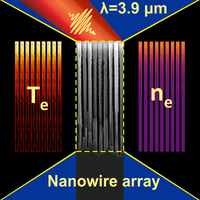Abstract
We report on experimental results in a new regime of relativistic light-matter interaction employing midinfrared ( wavelength) high-intensity femtosecond laser pulses. In the laser-generated plasma, electrons reach relativistic energies already for rather low intensities due to the fortunate scaling of the kinetic energy with the laser wavelength. The lower intensity efficiently suppresses optical field ionization and creation of the preplasma at the rising edge of the laser pulse, enabling an enhanced efficient vacuum heating of the plasma. The lower critical plasma density for long-wavelength radiation can be surmounted by using nanowires instead of flat targets. Numerical simulations, which are in a good agreement with experimental results, suggest that of the incident laser energy has been absorbed resulting in a long-living, keV-temperature, high-charge-state plasma with a density more than 3 orders of magnitude above the critical value. Our results pave the way to laser-driven experiments on laboratory astrophysics and nuclear physics at a high repetition rate.
- Received 25 May 2018
- Revised 14 February 2019
DOI:https://doi.org/10.1103/PhysRevX.9.021029
Published by the American Physical Society under the terms of the Creative Commons Attribution 4.0 International license. Further distribution of this work must maintain attribution to the author(s) and the published article’s title, journal citation, and DOI.
Published by the American Physical Society
Physics Subject Headings (PhySH)
Popular Summary
Studying how matter behaves under conditions of extreme temperature, pressure, density, and electromagnetic fields can improve our understanding of astrophysical objects and even the formation of the Universe. With no direct access to such objects, researchers must rely on theoretical models, but those models can provide reliable information only if they are benchmarked to experiments that, for example, simulate conditions like those inside the Sun. Ultrashort laser pulses focused onto a solid material are useful in this regard, but the energy deposition and, consequently, plasma heating is rather inefficient. To solve this problem, we combine long-wavelength laser pulses with specially designed nanostructures.
In the rising edge of the laser pulse, the intensity is sufficient to remove electrons from the atoms in a sample, thus creating plasma. This plasma shields the volume and acts like a mirror, reflecting the incoming light and suppressing laser energy absorption. Midinfrared laser pulses reduce the plasma formation at earlier times because of relatively low photon energy. Moreover, focusing the light on a nanostructured sample instead of a flat one helps to overcome the issue of low critical plasma density for the long-wavelength laser light and helps to increase the energy absorption. In our experiments, about 80% of the laser light is absorbed, resulting in a very hot and dense plasma.
This novel regime of interaction offers many intriguing possibilities for laboratory studies of the interiors of stars as well as for nuclear and strong-field physics.



